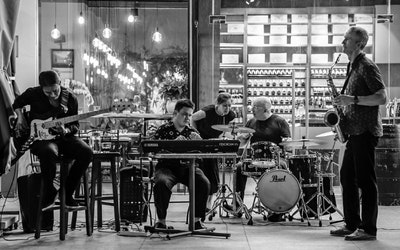Restaurants are experienced through all the senses and not just taste.
What customers see, feel, and smell all come together to bring an experience to life.
How a restaurant uses the customer’s senses to create an experience can be managed and used to increase sales.
Taste
 Samples are a great way to have customers try out your food without a massive cost to them or yourself.
Samples are a great way to have customers try out your food without a massive cost to them or yourself.
Sampling is cheaper than advertising and has the added benefit of the consumer experiencing your food and becoming an advocate for it. Samples are also exciting; consumers love free things and the opportunity to try something new. Samples can be served to those within the restaurant already, nearby canteens, supermarkets, or even on the streets.
A more diverse menu that caters to different tastes and dietary needs is also good for sales. Some consumers are on specific diets like veganism, dairy-free, keto, gluten-free, and so on. Catering to such diets makes you a viable option for large bookings because your menu will cater to large segments of the market.
Catering to diets does not necessarily mean building new cuisines, you can shift food you already serve into its own menu. For example, shifting vegetables found in your original dishes into their own list creates vegan options. Diets are about knowing what you eat, so explaining your recipes more clearly towards diet-conscious consumers opens up your menu to new customers.
More articles on restaurants >>>>
Touch
 Food is a very delicate product and consumers are naturally sensitive about it. They need to have the utmost confidence in its preparation and the environment in which they are consuming it. This is why cleanliness and neatness are paramount in creating a safe place to eat.
Food is a very delicate product and consumers are naturally sensitive about it. They need to have the utmost confidence in its preparation and the environment in which they are consuming it. This is why cleanliness and neatness are paramount in creating a safe place to eat.
Nobody wants to dine at sticky tables, stained tablecloths, be served by unkempt waiters, or have food that looks subpar.
With decor, soft comfortable settings and fabrics make customers want to stay around longer while hard, scant furniture is more suited for restaurants that want to keep customers moving.
On a psychological level, waiters should make customers feel emotionally touched. For the interaction between waiter and customer to be successful, waiters must have interpersonal skills and the ability to pick up on social cues. This friendliness will add to the overall impressions your restaurant leaves on customers.
Sight
 Lighting is something you can use to set the mood around your food. What type of lighting you should incorporate depends on the food you serve and the ambiance you want to create.
Lighting is something you can use to set the mood around your food. What type of lighting you should incorporate depends on the food you serve and the ambiance you want to create.
For example, fine dining restaurants use dim, yellow LED lights to create an intimate environment while fast-food restaurants use white fluorescent lighting that exudes excitement. Lighting has also to be planned so that every table receives the same lighting. Uniformity and symmetry are pleasing to the eye.
The design and color scheme of the restaurants are effective communicators. For example, light color schemes like beige, ivory, and pale yellow give of an atmosphere to relax and be comfortable, which is excellent if you want customers to stay longer like in fine dining restaurants. A different color scheme is needed for fast-food restaurants, which require high volume, quick foot traffic.
Fast food restaurants usually use bright colors like red, bright yellow, and green to create an exciting, always in motion environment.
The design of your menu can speak volumes on your restaurant. You’ll need a happy medium of what you order, so customers aren’t underwhelmed or overwhelmed with the number of options. Again, the fonts and colors you use should match your brand but look professional. Where items are placed on the menu can influence customers as well.
For example, people read top to bottom, left to right, and therefore it is smart to put your most expensive items at the very top. As the first option, if it sounds delicious enough, your guests might not read further and will spend more money on their meal.
In the past few years, restaurants have incorporated tablet POS at the tables. This intrigues customers for many reasons because:
-
They often feature electronic games, shows, or movies to keep children entertained. These options are typically an additional charge, which means a higher bill for guests to pay.
-
If there aren’t games, the tablet might feature a slideshow of intriguing illustrations to keep young guests entertained and wait times less painful.
-
It offers a quick way to pay.
Scent
 Visual stimulation is great for grabbing attention, but it’s only real when it is accompanied by smell. It’s the smell of food that makes customers’ mouths water. Using scent as a selling tool is called ambient scenting.
Visual stimulation is great for grabbing attention, but it’s only real when it is accompanied by smell. It’s the smell of food that makes customers’ mouths water. Using scent as a selling tool is called ambient scenting.
As customers walk into your restaurant, it’s the smell that tells them how good your food is. Smell stimulates our appetites and increase the chances of buying something. Coffee houses use scent to draw customers in and keep them longer using the inviting aroma of coffee.
The relation between scent and sales also applies to bad odors. Bad odors can be a huge turn-off and ruin your brand. Nobody wants to eat in a restaurant with smelly toilets. This means keeping your restaurant clean and actively keeping it fresh with proper ventilation, along with infusing it with pleasant scents like flowers.
Sound
 Music is an important background setting. It sets the mood. Music played should speak to the restaurant’s brand, target market, and atmosphere. You should consider changing the type of music played depending on the time of day or current events.
Music is an important background setting. It sets the mood. Music played should speak to the restaurant’s brand, target market, and atmosphere. You should consider changing the type of music played depending on the time of day or current events.
On a different note, word-of-mouth marketing is a great way for restaurants to grow their customer base. By implementing the tips and tricks mentioned above, you can ensure your restaurant’s excellence. Most people like to share enjoyable experiences either to their friends in person, on social media, or reviewing sites.
With that being said, if you’re providing a unique experience, you’re likely to have a large portion of new customers come based on others’ recommendations.
Using Senses to Increase Sales Makes Sense
 Appealing to customers’ senses is a smart way to drive traffic, sales, and loyalty.
Appealing to customers’ senses is a smart way to drive traffic, sales, and loyalty.
How the restaurant looks outside and inside will get people drawn to your establishment; what should bring them quicker is the smell of your food.
After that, every sense should be strategically satisfied once they walk into the place.
………………………………………………..
Managing the CX demands of 5 generations … new eBook – TheMarketingblog https://t.co/8jNKUb1aX4
— Will Corry (@slievemore) November 22, 2019

